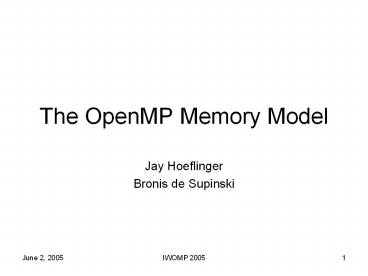The%20OpenMP%20Memory%20Model - PowerPoint PPT Presentation
Title:
The%20OpenMP%20Memory%20Model
Description:
Prevents re-ordering of accesses. Provides a guarantee that memory references are complete ... OpenMP re-ordering restrictions amount to weak ordering with ' ... – PowerPoint PPT presentation
Number of Views:53
Avg rating:3.0/5.0
Title: The%20OpenMP%20Memory%20Model
1
The OpenMP Memory Model
- Jay Hoeflinger
- Bronis de Supinski
2
Memory Model in Prior Specs
- No separate section
- Scattered in Execution Model, Flush description,
data sharing attribute section - Unclear, implied
3
OpenMP Memory Model in 2.5
- Model Structure
- Parts of the model
- Shared private access
- Memory coherence
- X-thread access private
- Flush in OpenMP
- Relaxed consistency
- Flush operation
- Flush guarantees consist.
- Volatile relates to flush
- Memory consistency
- Formal memory consist.
- Memory consist. of flush
- Flush operation specified with flush directive
4
Source code
OpenMP Memory Model Structure
compiler
Executable code
thread
thread
threadprivate
threadprivate
memory
a
b
Commit order
5
Shared and Private Access
- All shared and private variables have original
variables - Shared access to a variable
- Within the structured block, references to the
variable all refer to the original variable - Private access to a variable
- A variable of the same type and size as the
original variable is provided for each thread
6
Rules about cross-thread private access
pragma omp parallel private(x) shared(p0,p1)
Thread 0 x p0x x p0
Thread 1 x p1x x p1
Legal accesses
pragma omp parallel shared(x)
x p1
x p0
7
Flush Is the Key OpenMP Operation
Flush operation flush flush-set
- Prevents re-ordering of accesses
- Provides a guarantee that memory references are
complete - Provides the mechanism for moving data between
threads - Allows for overlapping computation with
communication
8
Implicit flushes
- In barriers
- At entry to and exit from
- Parallel, parallel worksharing, critical, ordered
regions - At exit from worksharing regions (unless nowait
is specified) - In omp_set_lock, omp_set_nest_lock,
omp_set_nest_lock, omp_unset_nest_lock - In omp_test_lock, omp_test_nest_lock, if lock is
acquired - At entry to and exit from atomic - flush-set is
the address of the variable atomically updated
9
Temporary View Allows Hiding Memory Latency
a can be committed to memory as soon as here
a . . . ltother computationgt pragma omp
flush(a)
or as late as here
10
Re-ordering Example
(1) and (2) may not be moved after (5). (6) may
not be moved before (5). (4) and (5) may be
interchanged at will.
a ... //(1) b ... //(2) c ...
//(3) pragma omp flush(c) //(4) pragma omp
flush(a,b) //(5) . . . a . . . b . . . //(6) .
. . c . . . //(7)
11
Moving data between threads
- To move the value of a shared var from thread a
to thread b, do the following in exactly this
order - Write var on thread a
- Flush var on thread a
- Flush var on thread b
- Read var on thread b
12
But Explicit Flush is HARD to Use Correctly
Acknowledgement Yuan Lin, Sun Microsystems
Producer data produce_new !omp
flush(data) flag 1 !omp flush(flag) Consumer
flag 0 do !omp flush(flag) while (flag
.eq. 0) !omp flush(data) consume_data data
Producer data produce_new !omp flush(data,
flag) flag 1 !omp flush(flag) Consumer flag
0 do !omp flush(flag) while (flag .eg.
0) !omp flush(flag, data) consume_data data
13
Sequential Consistency
- In a multi-processor, ops are sequentially
consistent if - Commit order program order in each thread
- Same overall order seen on all threads
program order code order commit order
14
Weak Ordering
- Memory ops must be divided into data ops and
synch ops - Data ops (reads writes) are not ordered w.r.t.
each other - Data ops are ordered w.r.t. synch ops and synch
ops are ordered w.r.t. each other
15
OpenMP ordering weak ordering
- OpenMP re-ordering restrictions amount to weak
ordering with flush identified as a synch op. - But, its weaker than weak ordering.
Relaxed memory model enables use of NUMA
machines especially cluster implementations of
OpenMP
16
OpenMP Locks and Flush
- Is a flush implied for OpenMP lock routines?
- Fortran 2.0 is silent, but lock routines are not
included on list of places where flush is implied - C/C 2.0 also silent, but
- There may be a need for flush directives to make
the values of other variables consistent. - Various people on previous committees say the
answer is no. - But, people have not gotten the message
17
Typical OpenMP lock code
!omp parallel . . . call
omp_set_lock(lock) count count 1 call
omp_unset_lock(lock) . . . ! omp end
parallel
18
Example of incorrect codeSPEC OpenMP Code ammp
ifdef _OPENMP omp_set_lock((a1-gtlock)) endif a
1fx a1-gtfx a1fy a1-gtfy a1fz
a1-gtfz a1-gtfx 0 a1-gtfy 0 a1-gtfz 0 xt
a1-gtdxlambda a1-gtx - a1-gtpx yt a1-gtdylambda
a1-gty - a1-gtpy zt a1-gtdzlambda a1-gtz -
a1-gtpz ifdef _OPENMP omp_unset_lock((a1-gtlock))
endif
19
Summary
- In 2.5, memory model is explicit
- Cross-thread private access rules
- Description of flush and how to use
- Relates OpenMP consistency to formal consistency
models - Locks imply no-list flush































